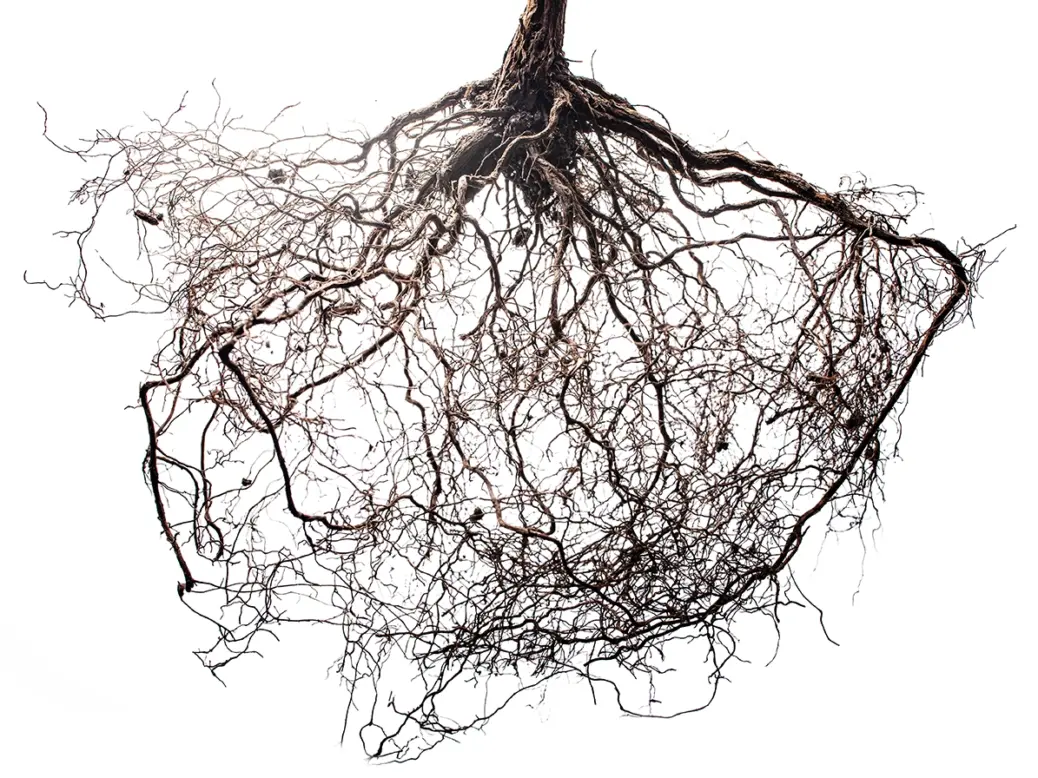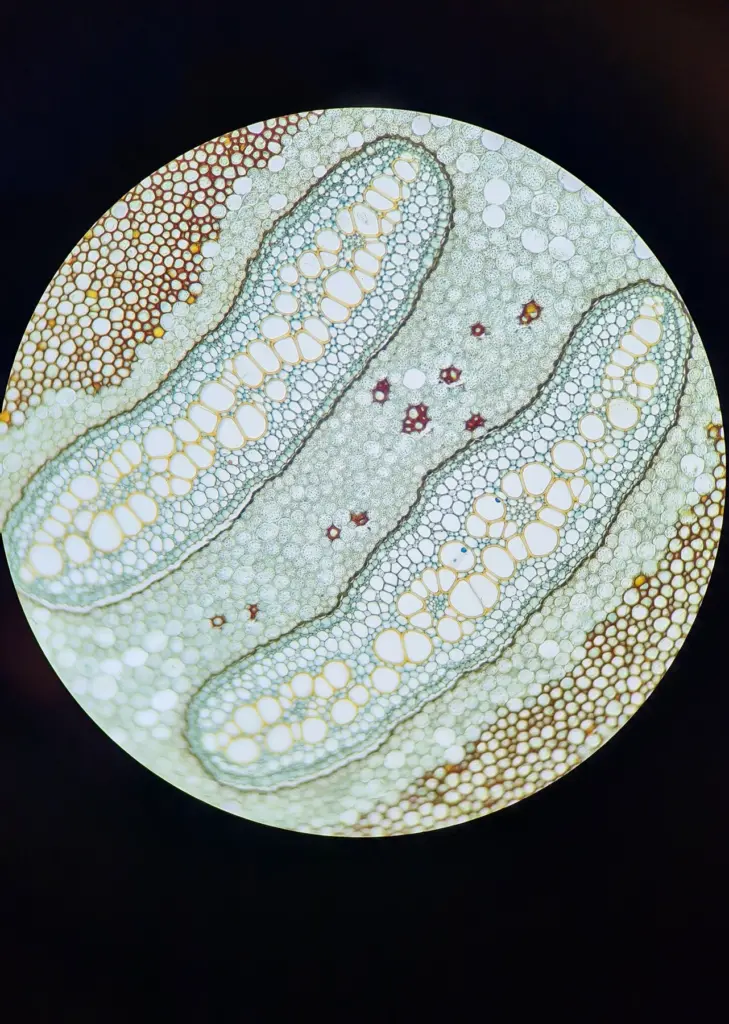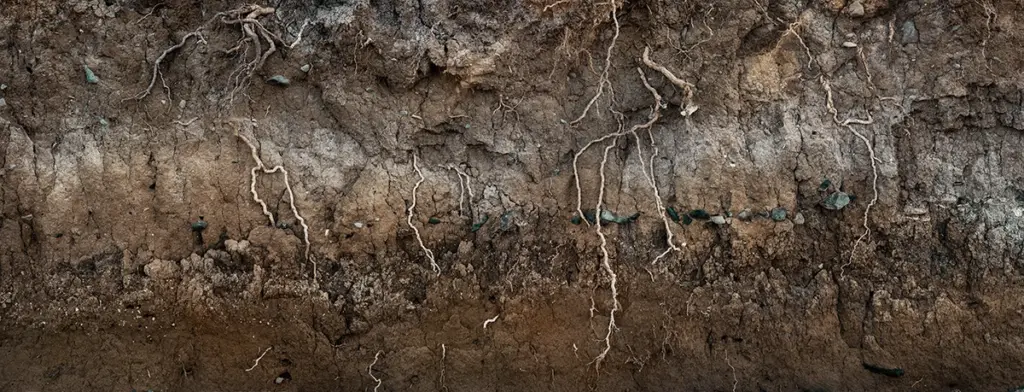
Scientists continue to have some success in unraveling the inner workings of a vine root’s rhizosphere and microbiome, the critical realms in a plant’s search for food and water. But they are still just scratching the subsurface of the underground culture of the world’s vineyards. As Roger Morris reports, debates rage as to whether a root has a social life, and researchers continue to ask, “What does a vine root know, and how does it know it?”
The silence of the vines can be maddening. Like jealous lovers, we worry if they are happy and whether we can ever completely satisfy their desires.
We prune this way then that. We green-harvest, then we don’t. We are sure that high density is the way then worry the vines feel too crowded. We apply tough love and cut off water so the vines will dig deeper to survive. We even try to guess the vines’ favorite animal. Is it the plow horse replacing the heavy tractors, or do the vines prefer smelly sheep and no tilling at all?
While we know there is constant communication going on between the leaves of the vine and its roots far below ground, we don’t hear or see this conversation. The best we can do is try to eavesdrop by observation, and we know we can’t observe everything about the whole plant because we only see half of it—the part above ground. We are like a physician trying to diagnose a patient in the examination room without knowing what’s happening in the microbiome within their gut.
Add to this the fact that for centuries we have thought of terroir mainly in terms of things that are inert—limestone, clay, loam, gravel, sand, water, and the minerals they contain—and understandably so. But increasingly, soil scientists have turned their attention to the interaction of a vine’s roots and the literally millions of microorganisms, both flora and fauna, with which they come into contact underground.
This raises questions: How does a vine root get sustenance from the soil in order to produce what the above-ground plant signals it needs to grow and yield grapes? How does it avoid pathogens? Do vine roots communicate with the roots of other plants? How do they know in which direction to explore for nutrients and water? Can the root, as part of the plant’s distributed “brain,” think? Some of these questions have verifiable answers. Others remain mysteries.
The rhizosphere and microbiome
In his 1998 book Terroir, the late James E Wilson gives an excellent synopsis of how terroir anywhere works:
Soil microorganisms include fungi (mold and yeast), algae, actinomycetes, and bacteria which are both aerobic (needing oxygen) and anaerobic (living without oxygen). Fungi and actinomycetes are particularly useful as their bacterial “glue,” the web-like fabric they create, help build soil aggregates by sticking particles together. The actinomycetes are single-cell creatures whose main function is to decompose organic matter. Microorganisms function best under alkaline soil conditions.
But how does the vine interact with these creatures once it takes up residence underground? Of all the things that happen when a vine root burrows into this vast underground, the most important interactions take place inside the few millimeters of soil surrounding the vine root and extending into the thin outer layers of the root itself. This area—part plant, part soil—is the rhizosphere.
“Pull a root out of the ground and give it a hard whack to knock off all the dirt, and what you have left is the rhizosphere,” says Miranda Hart, a researcher at the University of British Columbia, Okanagan, who has recently been conducting scientific research into the efficacy of fungal inoculants for grapevine roots.
Think of the rhizosphere as an exchange zone, a teeming international border crossing, a frontier immediately surrounding a root’s outer area at the edge of the vastness of soil beyond. Everything that the plant needs below ground, and everything that needs the plant, for good or bad intentions, congregates here. Soil scientists like to tell the uninitiated that there are more microorganisms in one shovelful (some even say teaspoon) of ordinary soil than there are people living on earth.
The word “rhizosphere” was coined by the German researcher Lorenz Hiltner in 1904 to describe this interface of root and soil. Today, dozens, perhaps hundreds, of researchers worldwide are still probing the vastness of such a small space. In an article in Nature Education, University of Kentucky soil scientist David McNear writes, “The rhizosphere is not a region of definable size or shape, but instead consists of a gradient in chemical, biological, and physical properties which change both radially and longitudinally along the root.”
In a recent conversation, McNear further explains that activity is not uniform along the root structure. “Instead,” he says, “it is comprised of ‘hot spots’ and ‘hot moments.’ Hot spots are located around actively growing root tips that are moving through the soil, releasing carbon and taking up water and nutrients, while hot moments are those regions located behind the progressing root tip where life is returning to pre-root tip status.”
In his article, McNear explains that the rhizosphere is further divided into three vaguely defined parts:
The endorhizosphere includes portions of the cortex and endodermis in which microbes and cations can occupy the “free space” between cells (apoplastic space). The rhizoplane is the medial zone directly adjacent to the root including the root epidermis and mucilage. The outermost zone is the ectorhizosphere which extends from the rhizoplane out into the bulk soil.
Before you turn the page to move on to something else, this is about as scientific as we will get. But it is important in caring for vines to have a better understanding of what the rhizosphere has to do in the short and long run with growing better grapes.
At its most basic, what takes place in the rhizosphere is that a plant collects the carbon that its leaves gather above ground and transports it underground through its vascular system to exchange for food—minerals—and water that the whole plant needs to survive and produce grapes. What the above-ground plant signals it needs from underground will depend on, among other things, its growth stage and the weather. And what it signals that it needs dictates the chemical form the carbon takes. Together, these carbon forms or metabolites constitute a plant’s “metabolome.”

In exchange for the carbon, the plant seeks out such crucial “macro-nutrients” as nitrogen, phosphorous, and potassium, as well as calcium, magnesium, sulfur, iron, manganese, molybdenum, copper, zinc, and boron. Although it’s fair to say a grape or a wine has “mineral tastes,” the understandable desire for even seasoned wine tasters to say they can taste the limestone soil of Chablis or the slate substrate of Mosel Rieslings is not literally correct. Carole Meredith is a retired researcher at UC Davis, well known for tracking down the generic heritage of many grape varieties. “Plant roots are selective,” Meredith explains to me. “They do not just suck up whatever is in the soil; instead, they selectively take up ions from the soil solution. Ions are small molecules, whereas minerals like slate and limestone are large and complex. The fact that the taste of the soil doesn’t carry through to the wine is actually a long-established basic principle of plant biology.”
Returning to the plant’s metabolome, its contents will help dictate the community structure and activity of the microbiome forming within the rhizosphere. This in turn determines what microbes the plant attracts and which it will try to repel. In a perfect underground, it will attract only symbiotic visitors, those that need something from the plant, such as carbon, while giving something to the plant that it can’t directly access, such as unprocessed minerals. This occurs as chemical interchanges.
While what’s in the soil will naturally determine a large part of a root’s microbiome, the root itself brings its own set of microorganisms to the party. In an article in an issue of Frontiers in Microbiology (May 22, 2019), University of Rioja researcher Carmen Berlanas and her colleagues reported that each type of rootstock carries with it “a ‘core’ grape phylogeny that is independent of the growing region.”
McNear explains that fungi in general are among the most important and most readily perceived good guys, associated with more than 80 percent of the world’s land plants—trees, weeds, cover crops, and grape roots. “It’s a beautiful symbiosis between the plant and the fungus,” he says. “The plant invites the fungus inside the root, where it grows between and presses into the root cells,” McNear says. “The fungus and its fine hair-like hyphae extend out into the soil, quadrupling the root surface area and accessing phosphorous and other minerals from the tiny spaces a plant cannot and transports them back to the plant along this hyphal superhighway. In exchange, the fungus gets carbon.” These creatures are referred to as AMF—arbuscular mycorrhizal fungi.
Of course, the most-dreaded interactions are those with pathogens such as phylloxera, perhaps the most deadly and most widespread of all grape diseases constantly trying to break through the cells’ barriers. Phylloxera is a good lesson in the complexities of life underground because it illustrates a simple fact that most wine growers seem almost intuitively to know: Each root or rootstock has different matabolomes and microbiomes. As a result, individual rootstocks vary in how they influence the performance of the plant above the graft and whether it will survive the attacks of pathogens.
Karl Lund is a geneticist and rootstock researcher at the University of California’s agricultural extension service’s research center at Madera in the state’s vast Central Valley. “With roots for rotundifolia or muscadine, the nematodes don’t seem to see it as food—why, we don’t know—but they will just walk away.” Another form of plant resistance appears in roots that are hypersensitive to nematodes, so when nematodes start eating, the wood around the site dies off and isn’t seen as food any longer. Since these are just feeder roots, it’s not a problem for the vine.
“But the interesting part is when we switch to phylloxera,” Lund continues. “On most rootstocks, phylloxera attacks the feeder roots only. However, with Vitis vinifera, which covers all the major wine, table, and raisin varieties, phylloxera can feed on the mature, lignified root system”—hence the vulnerability of ungrafted vines.
Of course, there are other interesting activities taking place underground beyond the rhizosphere, including ones that cause scientists to debate what a root knows and how it knows it.
The underground universe
Long before humans created vineyards, ancient grapevines congregated in forests, especially around the edges of woods, so that they could take full advantage of nature’s posts and cordons—the trunks and limbs of the tallest of trees. In fact, “savage” or “wild” grapevines still search for sunlight this way today. And if they are this intertwined in the sunlight, imagine what goes on in the dark reaches of the midnight soil.
Thomas Duroux, CEO of Château Palmer in Margaux, does not want his Cabernet and Merlot to use trees as rustic pergolas, but he nevertheless surprised his neighbors (and Palmer’s owners) a decade ago when he planted fruit trees and hedgerows selectively within Palmer’s vineyards. Partly, he says, this was to bring a diversity of birds and insects, even small grounded animals, to the vineyard to build up a more-integrated ecosystem above ground and perhaps even produce interesting results below the surface as well.
“I’ve talked with the older guys in Bordeaux who always said that the best-tasting grapes were those nearest the trees, and I heard the same thing while I was in Italy,” Duroux says. “We have done some studies, but we are still in the beginning phase.” Most of these studies were conducted by University of Rennes researcher Marine Biget, a prominent advocate of the holobiont concept of a super-community composed of the host plant and all living things around and within it.

While Duroux remains an outlier among Bordeaux wine growers in planting trees in his vineyards, two well-known researchers—one in Italy, another in Canada—are adamant that plants of all sizes have intelligence and a social life with other plants. Both have written books for the layman, and both have received a lot of publicity in the popular press, resulting in a certain degree of skepticism among their colleagues. One is Italian plant biologist Stefano Mancuso, author of the 2013 volume Brilliant Green: The Surprising History and Science of Plant Intelligence, and the other is Canadian professor of forest ecology Suzanne Simard. Her 2021 book Finding the Mother Tree: Discovering the Wisdom of the Forest argues that trees in the forest not only cooperate at the root level to survive but that they are also altruistic in taking care of younger trees first.
In Brilliant Green, Mancuso says plants have more senses than we do, at least 15, compared to our measly five. “For example, they sense and calculate gravity, electromagnetic fields and humidity, and they can analyze numerous chemical gradients.” And, he says, unlike humans with our single unwieldy brain, plants are “equipped with numerous ‘command centers’ and a network structure not unlike the Internet’s.” And for good measure, “Plants could live without us, in general. But without them, we would die out very quickly.”
In Mother Tree, Simard writes, “The trees soon revealed startling secrets. I discovered that they are in a web of interdependence, linked by a system of underground channels, where they perceive and connect and relate with an ancient intricacy and wisdom that no longer can be denied.” Scientifically, theses fungal mazes are called common mycorrhizal networks, or CMNs for short.
It is important to note that both Simard and Manusco are qualified scientists, but it also important to note that probably most qualified scientists appear to disagree with their personification of plants as being intelligent, caring beings. In an article in the February 13, 2023, issue of Nature, Ecology & Evolution, the authors charge:
The claims that CMNs are widespread in forests and that resources are transferred through CMNs to increase seedling performance are insufficiently supported because results from field studies vary too widely, have alternative explanations, or are too limited to support generalizations. The claim that mature trees preferentially send resources and defense signals to offspring through CMNs has no peer-reviewed, published evidence.
While the intelligence, or lack of it, in plants can be debated, we do know that vine roots intermingle with those of other vines and, often, the roots of nearby trees and bushes. It would seem natural that the rhizospheres and microbiomes of the various plants could intermingle in this maze of roots. The effect of that would seem to depend on the roots involved and the surrounding soil, as well as what is going on above ground. Additionally, the presence of other roots could signal competition for resources, just as there are above ground in trying to maximize access to sunlight.
Another persistent question is how does a vine root know where to look for food and water? An article in Science News (dated February 12, 2020) reports on a study at Goethe University in Frankfurt that sums up the most recent findings: “While the main root digs downwards, a large number of fine lateral roots explore the soil on all sides. Interestingly, lateral roots appear to already ‘know’ very early on where they can find water.”
Yet we still don’t know how they know. And perhaps we shouldn’t be surprised. How much do humans know about how our own brains work, much less how our senses similarly seem to “know” that someone is watching us or how feelings of déjà vu are mysteriously triggered? After all, beyond the protein-coding genes that represent only about 1.5 percent of our DNA, much of our genome is still a vast mystery.
Finally, we return to what these silent plants may want from us. For millennia we have known that vines often need additional food, and we have fertilized them—indeed, overfertilized them—from above ground. Now, through the application of fungal bioinoculants such as arbuscular mychorizal fungi (AMF), growers are trying to improve upon how nutrients are taken up within the rhizosphere—in essence, to stimulate the feeding process.
This practice divides wine growers into those who want to induce better growth naturally and those who want to provide man-made intermediaries. So far, the efficacy of these inoculants is still somewhat in question. Researcher Miranda Hart, who gave us that graphic “whack the root” rhizosphere definition at the beginning of this article, and her colleagues are skeptical on how well all this outside help works.
In a 2018 article in Functional Ecology, Hart et al note that, while bioinoculants are “rediscovered” every ten years or so, “evidence for their efficacy is scant, incomplete, or lacking altogether. Perhaps more troubling is that the scientific community has little idea of the ecological consequences of the use of AMF inocula.”
So, what to do with all of this information—what we know and what we don’t—about our silent partners’ lives underground? Those who commercially produce enhancers such as chemical fertilizers, sprays, and inoculants will continue to tinker with their formulae. Those who believe plants are intelligent and social beings will continue to conduct trials to convince the rest of us. Those who believe in increasing the diversity of all living things above and below ground will try to better understand how it all comes together in the rhizospheres and microbiomes of the vines—though the jury is still out on whether this diversity in the aggregate has its negatives as well as positives.
Through it all, the vines will remain silent, waiting to discover what those of us above ground will come up with next.






